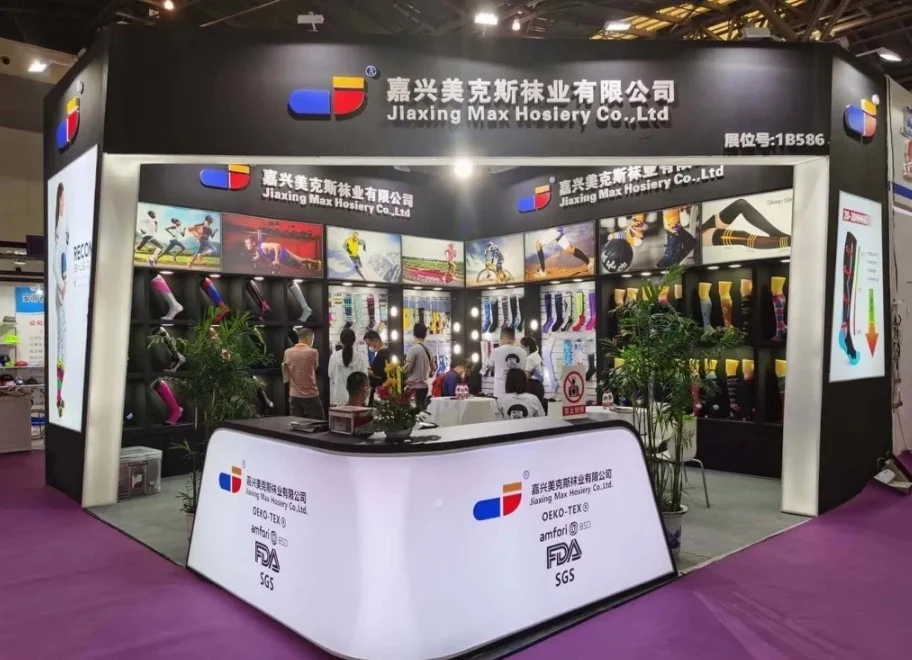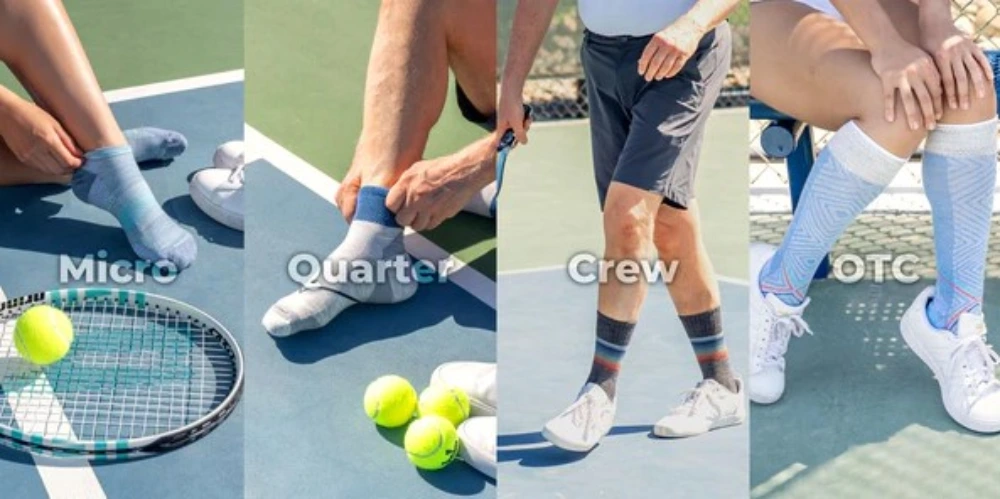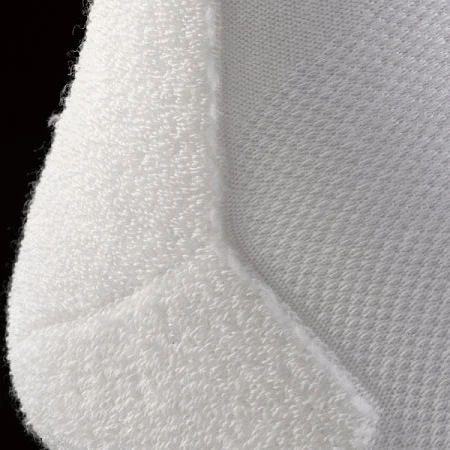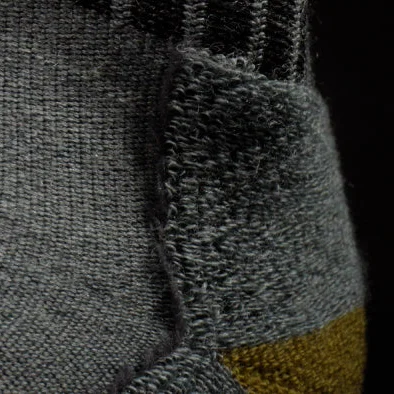Socks seem simple, but wrong socks can ruin your day. They slip, bunch, or smell bad. Learn how to pick perfect pairs every time.
This guide covers sock heights, weights, materials, designs, and uses so you can pick comfortable, long-lasting, and stylish socks for any activity. It shows what to look for in every category.

Keep reading to dive into every detail and find socks that fit your needs and style.
Socks by Height
Too tall or too low socks can slip or show at the wrong time. You need the right height for shoes and activity. Let’s break down heights.
Socks come in heights from no-show to thigh-high, each for different shoes and uses. Choosing the correct height prevents slipping, improves comfort, and keeps your look sharp.
Height Groups
| Height | Description | Best for |
|---|---|---|
| No-Show | Hidden under shoe line | Low-cut shoes |
| Ankle | Sits at the ankle bone | Sneakers, casual wear |
| Crew | Mid-calf | Boots, everyday wear |
| Knee-High | Just below the knee cap | Cold, uniforms |
| Over-the-Knee | Above the knee | Fashion, extra warmth |
| Thigh-High | Mid-thigh | Style statement |
You pick no-show socks when you want no sock line. They hide under low-cut shoes. Ankle socks cover the ankle but stay low. They work well with sneakers and shorts. Crew socks reach mid-calf. They suit boots and daily wear. Knee-high socks hit just below your knee. They add warmth and work with uniforms. Over-the-knee and thigh-high socks go above the knee. They make a bold look and keep legs extra warm. Each height has a job. Choose by shoe style and weather. Test a few heights to see what feels best.
Socks by Weight
Thin or thick socks feel very different. You may overheat or shiver if you pick the wrong weight. Let’s look at sock weight.
Sock weight refers to how thick the yarn is, not their mass. Ultralight socks suit hot days, while heavyweight socks keep you warm in cold weather.
Weight Categories
| Weight | Yarn Thickness | Best Use |
|---|---|---|
| Ultralight | Very thin | Running, hot weather |
| Lightweight | Thin | Dress, daily wear |
| Midweight | Medium | Hiking, all-year wear |
| Heavyweight | Thick | Cold weather, mountaineering |
Ultralight socks are almost like a ghost. You feel your shoe more. They let your feet breathe. They work best for running and hot days. Lightweight socks feel thin but a bit more cushion. They work with dress shoes and daily use. Midweight socks offer a good balance of cushion and breath. They suit hiking and most seasons. Heavyweight socks use thick yarn. They trap heat. They keep feet warm in cold or snowy weather. Pick sock weight by your needs. Use thin socks in warm weather and thick socks in cold. You can layer socks too. A thin liner plus a thicker sock adds warmth.
Socks by Activity
One pair for all tasks rarely works well. You need socks that match your sport or work. Let’s sort socks by activity.
Different activities need specific sock features. Running socks wick moisture, hiking socks add cushion, and work socks protect feet in tough conditions.
Activity Types
Athletic and Running

Running socks use ultralight or lightweight yarn. They wick sweat and dry fast. They often have a snug fit. Some have extra mesh vents for airflow. A snug arch band stops slipping. Thin padding helps prevent blisters but does not add bulk.
Hiking and Outdoor
Hiking socks are usually midweight or heavyweight. They use wool or blends. They add cushion under the foot and heel. Some have extra padding around the calf. These socks protect from blisters and keep feet dry on long trails.
Work and Tactical
Work socks are durable and often have targeted cushioning. They protect against steel-toe boots and long hours. Tactical socks meet military standards. They use high-strength fibers for longevity and may have antimicrobial finishes. Finding the right work and tactical pair for your specific demands is essential for all-day comfort and performance.
Casual and Lifestyle
Lifestyle socks cover daily use. They come in many colors and patterns. They range from ankle to crew heights. They focus on comfort and style. They use cotton or soft blends.
Home and Medical
Home socks are slipper style or leg warmers. They add warmth at home. Medical socks include compression styles. They help improve circulation and reduce swelling during long flights or for medical conditions. From cozy comfort to therapeutic support, our collection addresses a wide range of needs.
Pick socks that match your main activity. You get better comfort and performance. Swap socks when you switch activities.
Socks by Material
Material makes a big difference in feel, warmth, and care. It also affects odor and durability. Let’s review common and advanced sock fabrics.
Sock materials range from cotton and wool to high-tech fibers like graphene yarn and silver ion blends. Each offers unique benefits for comfort, warmth, and hygiene.
Material Options
| Material | Feature |
|---|---|
| Organic Cotton | Soft, eco-friendly |
| Merino Wool | Moisture-wicking, warm |
| Alpaca Wool | Soft, durable, warm |
| Bamboo | Breathable, eco-friendly |
| Silk | Smooth, lightweight |
| Nylon/Polyester | Stretch, strength |
| Coolmax | Fast drying, cool to touch |
| Graphene Yarn | Heat regulation, durable |
| Silver/Copper Fibers | Antimicrobial, odor control |
| Synthetic Blends | Cost-effective, versatile |
Organic cotton is gentle on skin. It is grown without harsh chemicals. Merino wool is soft and sheds moisture well. Alpaca wool adds extra warmth and lasts long. Bamboo offers breath and a soft feel. Silk feels luxurious but needs gentle care. Nylon and polyester add stretch and shape. Coolmax moves moisture and keeps feet cool. Graphene yarn helps spread heat and adds strength. Silver and copper fibers fight bacteria and odor. Synthetic blends mix fibers for balance. Choose material by your activity and skin needs. Wool and alpaca work for cold. Coolmax and graphene suit warm, active days. Antimicrobial blends keep socks fresh longer.
Socks by Cushion
Cushion level affects impact and breath. Too much cushion can feel bulky. Too little can cause pain. Let’s see cushion types.
Cushion comes in no cushion, standard, contoured, targeted, and full cushion. Each level changes how a sock absorbs shock and fits your foot.


Cushion Types
| Cushion Type | Coverage | Benefit |
|---|---|---|
| No Cushion | None | Light, breathable |
| Standard | Underfoot | Basic padding |
| Contoured | Underfoot & heel | Better fit |
| Targeted | Specific zones | Extra protection |
| Full Cushion | Throughout sock | Maximum comfort |
No-cushion socks have no extra loops. They keep things light. Standard cushion adds loops underfoot. It gives basic padding. Contoured cushion shapes loops to your foot. It fits better and reduces wrinkling. Targeted cushion adds padding in key areas. Use for work boots or skiing. Full cushion fills the whole sock. It adds warmth, comfort, and impact protection. Too much padding can make a shoe tight. Too little can cause pain on hard surfaces. Pick cushion by activity and shoe fit. Try different levels to find your sweet spot.
Socks by Design & Pattern
Designs and patterns let you show style. They don’t change comfort. Yet they help you express mood. Let’s look at sock art.
Sock patterns range from solid and stripes to tie-dye and abstract. Bold or simple, designs add flair and make socks easy to match in the wash.
Popular Patterns
| Pattern | Style |
|---|---|
| Solid | Minimalist |
| Striped | Classic |
| Tie-Dye | Vibrant |
| Animal Prints | Fun, whimsical |
| Nature Scenes | Scenic, outdoors |
| Abstract | Modern, bold |
| Holiday Themes | Seasonal fun |
Classic solids and stripes work with any outfit. Tie-dye adds a splash of color and a retro feel. Animal prints bring a playful vibe. Nature scenes show landscapes or plants. Abstract patterns play with shapes and color. Holiday and novelty socks add cheer at events. Pick patterns that fit your mood and outfit. Swap plain socks for bold prints when you want to stand out. Store patterned socks together so you can find pairs fast.
Beyond patterns and colors, adding custom logos is a popular way to personalize socks. Here’s a short video showing common logo application methods that bring style and brand identity together.
By Gender & Age
Socks need to fit your foot size and style. Babies, kids, men, and women have different needs. Let’s match socks to people.
Socks come in baby, kids, men’s, women’s, and unisex sizes. Each group has size and design tweaks to ensure comfort and fit.
Size Guide
| Group | Size Range | Key Feature |
|---|---|---|
| Baby | 0–12 months | Ultra-soft, gentle fit |
| Kids | 1–12 years | Fun prints, grip soles |
| Men | US 6–12+ | Larger fit, solid tones |
| Women | US 5–10 | Snug fit, diverse colors |
| Unisex | Various | Neutral designs, stretchy |
Baby socks are extra soft and small. They stay on tiny feet. Kids’ socks come in bright prints and may have grips. Men’s socks use neutral colors and roomy fit. Women’s socks offer more color and slimmer cut. Unisex socks blend styles and sizes for anyone. Check size charts before you buy. A good fit keeps socks from slipping or wrinkling. Match colors and patterns to age and gender for best look.
Sock Pairing Suggestions
Choosing socks by outfit boosts your style. Socks can match or contrast with shoes and clothes. Let’s pair socks well.
Pair no-show socks with loafers, crew socks with boots, and bold patterns with neutral outfits. Right sock choice ties your look together.
Pairing Tips
Shoes
- Sneakers: Ankle or crew socks.
- Loafers: No-show or thin liners.
- Boots: Crew or knee-high for support.
Pants
- Match sock color to pants or shoes.
- Dark pants work with dark socks.
- Light pants suit light or patterned socks.
Suits
- Solid, thin dress socks.
- Match sock color to trousers.
- Subtle patterns for a bit of flair.
Socks finish your look like a tie or belt. With sneakers, use ankle socks to keep it casual. Dress shoes call for thin, dark socks. Boots need taller socks to stop friction. Match sock color to pants or shoes to look neat. Use patterns when rest of outfit is simple. Change socks to add or tone down color. Keep a mix of basics and fun prints.
Socks by Foot Type
Your foot shape matters. Flat feet, high arches, wide or narrow feet each need a sock fit. Let’s find the right sock form.
Sock fit varies by foot type. Flat feet need arch support, high arches need cushion, and wide feet need stretch. Correct socks ease pain and improve posture.
Foot-Type Match
| Foot Type | Recommended Socks |
|---|---|
| Flat Feet | Arch-support |
| High Arches | Extra cushioning |
| Wide Feet | Stretch fit |
| Narrow Feet | Snug fit |
| Bunions | Soft, seamless toe |
Flat feet benefit from socks with built-in arch support. They lift the arch and ease strain. High arches need more padding under the ball and heel. Wide feet need socks with extra stretch. Narrow feet do best with snug socks to avoid wrinkles. Bunions need soft, seamless toe boxes to reduce pressure. Swollen feet can use gentle compression socks for comfort. Test socks in store if you can. Look for stretch panels or special fits. Proper sock choice reduces pain and helps you move better.
Sock Care and Maintenance
Good socks last longer with proper care. Wrong washing can shrink or damage fibers. Let’s cover sock care.
Wash socks by material: cold for wool, warm for cotton and synthetics. Air dry or tumble low to keep shape and avoid shrinkage. For more on sock care, you can see this guide on how to keep your socks white.
Washing Guide
| Material | Wash Temp | Drying |
|---|---|---|
| Wool/Alpaca | Cold | Air dry |
| Cotton/Organic | Warm | Tumble low |
| Synthetics | Warm | Tumble low |
| Mixed Blends | Cool | Air or low |
Sort socks by color and material. Turn dark socks inside out to keep color. Use gentle detergent for wool and silk. Avoid bleach on colored and wool socks. Air dry wool to prevent shrink. You can tumble dry cotton on low. Store socks in pairs to find matches fast. Replace socks when they get holes or lose stretch. A sock drawer with dividers helps you organize by type. Proper care keeps socks soft and odor-free.
Conclusion
With this guide, you have clear steps to choose the right socks. Focus on height, weight, materials, cushion, and style to stay comfy and look good.
If any of these sock types caught your eye, you’re welcome to check out our full collection. We offer wholesale options, custom designs, and flexible support for growing brands.
Have questions or need samples? Just send us a quick message—we’re happy to help.
FAQs
What are the different types of sock materials?
Different sock materials include cotton, wool, silk, and synthetic blends. Each offers unique benefits like breathability, warmth, or moisture control. Choose based on activity and comfort.
How do I choose the right sock height?
Pick sock height by your shoe style and activity. No-shows work with loafers. Crew socks suit boots. Knee-highs add warmth. Fit matters most for comfort.
Which socks are best for running?
Running socks are usually lightweight and moisture-wicking. Look for a snug fit with minimal seams to reduce friction. A thin cushion helps protect without bulk.
How often should I replace my socks?
Replace socks every six to twelve months or when they show holes, loose fibers, or loss of elasticity. Fresh socks prevent discomfort and extend shoe life.
What does sock weight mean?
Sock weight refers to yarn thickness, not mass. Ultralight socks use thin yarns for breathability, while heavyweight socks have thick yarns for insulation and cushion.
What socks prevent blisters?
Cushioned socks with terry loops in high-impact areas help prevent blisters. Targeted cushioning under the heel and toes offers protection and comfort on long walks.
How do I wash different sock types?
Wash wool socks in cool water with gentle detergent. Machine wash cotton and synthetics on warm. Air dry to keep shape and prevent shrinkage.
What is the best sock for flat feet?
For flat feet, choose socks with arch support and extra midfoot cushion. Compression-style socks can improve stability and reduce foot fatigue.
